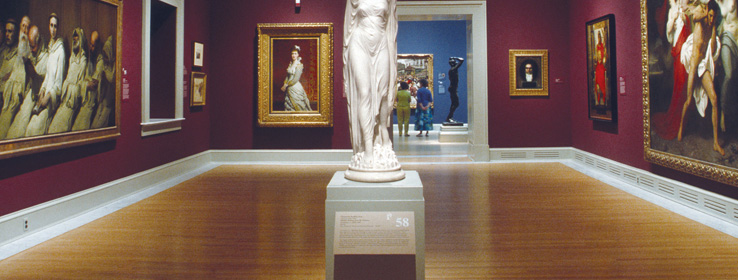Move over, "museum white." At the Chrysler Museum of Art in Norfolk, Va., the walls are as rich and vivid as the art itself.
In 1998, Jeff Harrison took a long, hard look at the Chrysler Museum of Art's gallery of neoclassical sculpture and saw red – deep, sumptuous red. "At the time, the museum walls were painted light gray, light blue and light green. They were to serve as neutral foils for the art and the architecture of the building," says Harrison, the Chrysler's chief curator. "We wanted to refresh the sculpture gallery, and one remarkably easy – yet dramatic – way was to introduce a radically different wall color."
Red had historical precedent, given that many 18th century sculpture galleries were painted that color, says Harrison. But history was far from his only guide when he began choosing colors for the rest of the galleries in the museum, which features the highly respected collection of American and European art amassed by auto heir Walter P. Chrysler Jr.
"When we repainted our Italian Renaissance gallery, we did not use red, which is historically used in Renaissance galleries," says Harrison. "The palettes of the paintings in the room were heavily weighted toward red, and I wanted a color that would serve as a chromatic opposite, so I went for dark green. The Old Masters paintings, which can be pretty dark, regain their lightness against the dark wall."
Over the next seven years, Harrison and his team worked gallery by gallery, converting the neutral palette into one that featured rich blue, saturated rose, electric teal and deep brown – each color chosen for its "sympathetic and dramatic effect" with the art. Thanks in part to advertising executives Bob Morrison and Steve Tobin of Virginia Beach-based ad agency Cortani, Morrison & Tobin, these colors are now part of the Sherwin-Williams line of Chrysler Museum Colors. When Morrison's wife saw the museum's newly painted walls for the first time, she said she wanted the colors for her own home – and the ad men, who previously had done work for the museum, saw the possibility of a partnership between the Chrysler Museum and Sherwin-Williams.
"We matched all the colors from the museum walls and sent them to our Color Marketing and Design department in Cleveland," says Jim Faucette, Norfolk district manager for Sherwin-Williams.
"They created a color card that is actually a piece of art – it's beautiful."
A Fresh Approach
Response to the Chrysler Museum Colors, launched in April, has been tremendous, says Lisa Jenkins, Sherwin-Williams architectural account executive for the Southeastern division. "To step inside one of the Chrysler galleries is to see firsthand how the rules of using color have changed," she says. "You won't see grays, neutrals or museum white," the traditional backdrop choices when displaying art because they help the wall disappear and draw attention to the piece itself. "Here the walls are magnified with color, bringing new dimension to the art and a new interpretation of the artist's expression. It's a new way of thinking about the relationship between color and art."
So, how much difference does a teal wall make in the Chrysler's early 20th century American gallery, home to pieces by Franz Kline, Edward Hopper and the artists of the Ashcan School?
"After the gallery was renovated, a member of our staff who knew the collection as well as anyone walked into the gallery, looked at a painting that had always been there and said, 'When did we get this?'" says Harrison. "It's night and day, absolutely transforming. It was literally like she was seeing it for the first time."
Make It a Masterpiece
HUE. Contrasting colors will make paintings "pop" off the wall. A dark wall will make a painting appear lighter. To create an accent wall, as well as highlight a painting, choose a color from the painting for that wall, then paint the other walls a different color.
TEXTURE. "Flat paint is typically a better choice to highlight art," says Jim Faucette, Sherwin-Williams district manager in Norfolk, Va. "There's no sheen, so the light reflection will come from the art, not the wall." If rich, dark colors look too heavy in a flat finish – or if art is displayed in a high-traffic area – choose a satin finish.
LIGHT. Using COLOR To Go™ paint samples from Sherwin-Williams, paint large pieces of poster board with the wall colors you're considering and hold them against the paintings to determine how the colors work with the art amid the natural and artificial light in the room. Or order 8 1⁄2″ x 11″ paint chips, which ship in a day from Sherwin-Williams.








